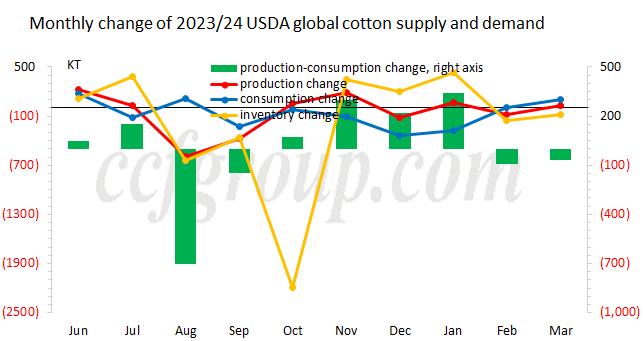Interpretation of USDA's Mar supply and demand report on cotton
USDA has released the global cotton supply and demand balance sheet for March last Friday. The adjustment mainly raised 2023/24 production and consumption, resulting in further tightening of ending stocks, but the adjustment was not significant and the overall direction was neutral. On the same day, ICE major cotton contract hit the down-limit and closed at 95.28cent/lb. The positive adjustment of the USDA's balance sheet had a limited impact on the market, and long positions taking profits brought pressure to the market, resulting in a final drop of 400 points.
1. Details of the USDA's March supply and demand balance sheet
Specifically, USDA raised the global production estimate for the 2023/24 by 30,000 tons, mainly reflecting an increase of 110,000 tons in the estimate for India's production. However, the reduction in US cotton production offset some of the increase. Imports were raised by 80,000 tons. Not surprisingly, the USDA repeatedly raised China's import estimate, which was increased by as much as 200,000 tons this time, while imports for Turkey and Pakistan were reduced by 40,000 tons each. For consumption, estimates were also raised for China and India, while consumption in Turkey further shrank, resulting in an overall increase of 100,000 tons. The export estimate was increased by 80,000 tons, mainly due to the expected recovery of India's exports. Finally, the estimate for ending stocks was reduced by 80,000 tons, resulting in a further reduction of US cotton ending stocks, while stocks in China continued to accumulate. Overall, the global ending stocks this year have shrunk to almost the same level as last year, and the low level of US cotton carryover stocks will continue to provide strong support to the market.

2. Interpretation of the USDA's March supply and demand balance sheet
1) Has the increase in India's cotton output estimate been overestimated?
According to the Cotton Association of India's (CAI) evaluation, 2023/24 Indian cotton production is only 4.9997 million tons, which is substantially lower than the USDA's estimate. However, based on the latest CAI data, the cumulative arrivals as of January 31 had reached 3.012 million tons, a year-on-year increase of 53.1%. If this pace continues, there should be no problem reaching last year's output level. Also, according to the AGM, the arrivals also exceeds the same period last year. CAI's downgrade of India's cotton production estimates is mainly due to the lack of rainfall last year and the impact of pests. However, the actual growth situation in the later period shows that the impact of pests is far less than expected, and there may be room for upward adjustments in harvest area. Therefore, the USDA's upward revision is not entirely unfounded, but the actual production may be slightly lower than the USDA's estimate.
2) Can China's cotton imports and consumption live up to expectations?
Based on the U.S. cotton export sales from China in recent weeks, it seems that the pace of imports has slowed significantly after the significant rise in ICE cotton. As of the week of February 29, China not only signed fewer new contracts but also canceled 9,000 tons of previously signed orders, resulting in a weekly signing of negative7,000 tons, while the export volumes for the previous weeks were only 400 tons and 160 tons respectively. Brazil is another important source of imported cotton for China, and the imports of Brazilian cotton has also started to decline seasonally according to recent data. While imports for January and February are still estimated to remain high, given the current domestic downstream situation, there may be few export orders and the price of Chinese cotton is lower than international cotton, resulting in difficulties in maintaining such a high import pace for imported cotton.
3) What is the impact of the downward revision in US cotton carryover stocks?
The USDA again reduced the estimate for US cotton production by 70,000 tons to 2.63 million tons, mainly due to a downward revision of yield estimates. According to USDA, as of March 7, 2024, US upland and Pima cotton cumulative inspection volumes were 2.662 million tons. With this production reduction, the amount of cotton inspected in has reached 101.2% of the estimated production. Given the timing, there is limited room for further growth in the inspection volumes, so production levels are expected to be fixed. Given the good progress in export sales, there is a basis for further downward adjustment in US cotton carryover stocks, and with adverse weather and low-quality cotton that does not meet delivery standards, the price support for US cotton remains strong. Therefore, it is difficult for price in the short term to fall sharply.
- Top keywords
- Cotton Price
- Cotton Futures Price
- Cotton Futures
- CZCE
- PTA Futures Price
- Chemical Fiber
- Polyester Prices
- Wool price
- PTA Futures
- Shengze Silk
- China
- Yarn Price
- price
- China Textile City
- Fibre Price
- Benzene Price
- Cotton
- Index
- Cotton Index
- PTA
- fabric price
- NYMEX
- Top 10
- textile industry
- Spot Cotton
- Cotton Yarn
- Polyester Price
- Futures
- PTA Price
- cotton yarn price

